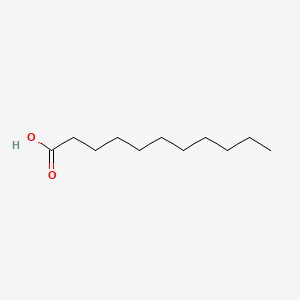| MeSH term | MeSH ID | Detail |
|---|---|---|
| Hemolysis | D006461 | 131 associated lipids |
| Alopecia | D000505 | 14 associated lipids |
UNDECANOIC ACID
UNDECANOIC ACID is a lipid of Fatty Acyls (FA) class. The involved functions are known as Anabolism, Mitosis, Transcriptional Activation, Mismatch Repair and Transcription, Genetic. Undecanoic acid often locates in Protoplasm and spindle microtubule. The associated genes with UNDECANOIC ACID are TERT gene. The related lipids are Fatty Acids and undecanoic acid.
Cross Reference
Introduction
To understand associated biological information of UNDECANOIC ACID, we collected biological information of abnormalities, associated pathways, cellular/molecular locations, biological functions, related genes/proteins, lipids and common seen animal/experimental models with organized paragraphs from literatures.
What diseases are associated with UNDECANOIC ACID?
There are no associated biomedical information in the current reference collection.
Possible diseases from mapped MeSH terms on references
We collected disease MeSH terms mapped to the references associated with UNDECANOIC ACID
PubChem Associated disorders and diseases
What pathways are associated with UNDECANOIC ACID
There are no associated biomedical information in the current reference collection.
PubChem Biomolecular Interactions and Pathways
Link to PubChem Biomolecular Interactions and PathwaysWhat cellular locations are associated with UNDECANOIC ACID?
Visualization in cellular structure
Associated locations are in red color. Not associated locations are in black.
Related references are published most in these journals:
| Location | Cross reference | Weighted score | Related literatures |
|---|
What functions are associated with UNDECANOIC ACID?
Related references are published most in these journals:
| Function | Cross reference | Weighted score | Related literatures |
|---|
What lipids are associated with UNDECANOIC ACID?
Related references are published most in these journals:
| Lipid concept | Cross reference | Weighted score | Related literatures |
|---|
What genes are associated with UNDECANOIC ACID?
Related references are published most in these journals:
| Gene | Cross reference | Weighted score | Related literatures |
|---|
What common seen animal models are associated with UNDECANOIC ACID?
There are no associated biomedical information in the current reference collection.
NCBI Entrez Crosslinks
All references with UNDECANOIC ACID
Download all related citations| Authors | Title | Published | Journal | PubMed Link |
|---|---|---|---|---|
| Kalinchenko SY et al. | Effects of testosterone supplementation on markers of the metabolic syndrome and inflammation in hypogonadal men with the metabolic syndrome: the double-blinded placebo-controlled Moscow study. | 2010 | Clin. Endocrinol. (Oxf) | pmid:20718771 |
| Saad F et al. | Testosterone as potential effective therapy in treatment of obesity in men with testosterone deficiency: a review. | 2012 | Curr Diabetes Rev | pmid:22268394 |
| Giagulli VA et al. | Evidence-based medicine update on testosterone replacement therapy (TRT) in male hypogonadism: focus on new formulations. | 2011 | Curr. Pharm. Des. | pmid:21521164 |
| Huang Q et al. | A medium-chain fatty acid receptor Gpr84 in zebrafish: expression pattern and roles in immune regulation. | 2014 | Dev. Comp. Immunol. | pmid:24704214 |
| Kanikkannan N et al. | Formulation and in vitro evaluation of transdermal patches of melatonin. | 2004 | Drug Dev Ind Pharm | pmid:15089055 |
| McCarney JP et al. | Conformational effects on the performance and selectivity of a polymeric pseudostationary phase in electrokinetic chromatography. | 2005 | Electrophoresis | pmid:15714565 |
| Kitazume T et al. | Kinetic analysis of hydroxylation of saturated fatty acids by recombinant P450foxy produced by an Escherichia coli expression system. | 2002 | Eur. J. Biochem. | pmid:11985584 |
| Edelstein D and Basaria S | Testosterone undecanoate in the treatment of male hypogonadism. | 2010 | Expert Opin Pharmacother | pmid:20642374 |
| Paião FG et al. | Analysis of Trichophyton rubrum gene expression in response to cytotoxic drugs. | 2007 | FEMS Microbiol. Lett. | pmid:17425668 |
| Ammendola S et al. | 10-undecanhydroxamic acid, a hydroxamate derivative of the undecanoic acid, has strong antimicrobial activity through a mechanism that limits iron availability. | 2009 | FEMS Microbiol. Lett. | pmid:19493009 |
